Science Says - October

By David Edgell, PhD
Q: With CRISPR, is the solution to many diseases just a matter of more computer power and more efficient delivery of the tool?
A: This is an interesting question that can be broken down into two parts: how to detect mutations that cause disease, and how to use CRISPR to treat the disease.
To answer the first part of the question it is important to understand that few human diseases result from a single defined mutation in DNA. Some examples would include cystic fibrosis or muscular dystrophy, but even in those cases there can be additional mutations that act as modifiers of the disease. Many human cancers are caused by multiple mutations in different genes.
The issue is further complicated by the fact that different types of cancers are caused by a different set of mutations. Computational power and DNA sequencing technology has advanced to the point where it is easy to sequence the DNA of a patient (even the DNA of cancerous tissue) and to analyze the sequence using computers. What is more difficult is identifying with confidence all the disease causing mutations and understanding how the mutations contribute to disease. This is a necessary prerequisite to CRISPR-based therapies.
The answer to the second part of the question is that the method of delivering CRISPR to the correct tissue in a patient is the most difficult aspect of any CRISPR-based therapy. Experiments have shown that CRISPR can be used to modify (or edit) DNA in idealized laboratory conditions, but technology for delivery of CRISPR to specific human tissues lags far behind the technology to modify DNA. One approach to circumvent this issue is to isolate the target population of cells from a patient, modify the cells to correct disease-causing mutations, and then inject the cells back into the patient. However, this methodology has limited applicability – blood bore diseases, for instance. A significant challenge for scientists in the future will be to develop specific delivery systems that will only target the disease-causing cells.
Another important consideration is that CRISPR is very good at inducing one particular type of DNA modification, gene ‘knock-outs’, but less effective at inducing another type of modification, gene 'knock-ins'. Knock-outs are useful in treating diseases where eliminating a gene function is beneficial. However, treatment of many diseases requires knocking-in DNA to correct the disease-causing mutation, and scientists are actively developing technology to make CRISPR more efficient at gene knock-ins.
David Edgell, PhD, is the Acting Chair, Department of Biochemistry, Schulich School of Medicine & Dentistry, Western University.
Edgell earned his BSc in Biochemistry and Microbiology at the University of Victoria and PhD from Dalhousie University. He then went on to complete post-doctoral studies at the Wadsworth Center, New York State Department of Health and State University of New York at Albany. In 2003, he joined the Department of Biochemistry, Schulich Medicine & Dentistry, Western University as an Assistant Professor and was appointed as an Associate Professor in 2009.
Edgell is the recipient of several awards including a Postdoctoral Fellowship from the Canadian Institutes of Health Research; an Early Researcher Award, Government of Ontario; a New Investigator Award from the Canadian Institutes of Health Research; the Dean’s Award of Excellence, Junior Faculty, Schulich Medicine & Dentistry; and a Faculty Scholar Award.
Edgell maintains an active research program in the areas of genome engineering and synthetic biology. His research is supported by grants from the Canadian Institutes of Health Research, Natural Sciences and Engineering Research Council of Canada, and Ontario Genomics.








